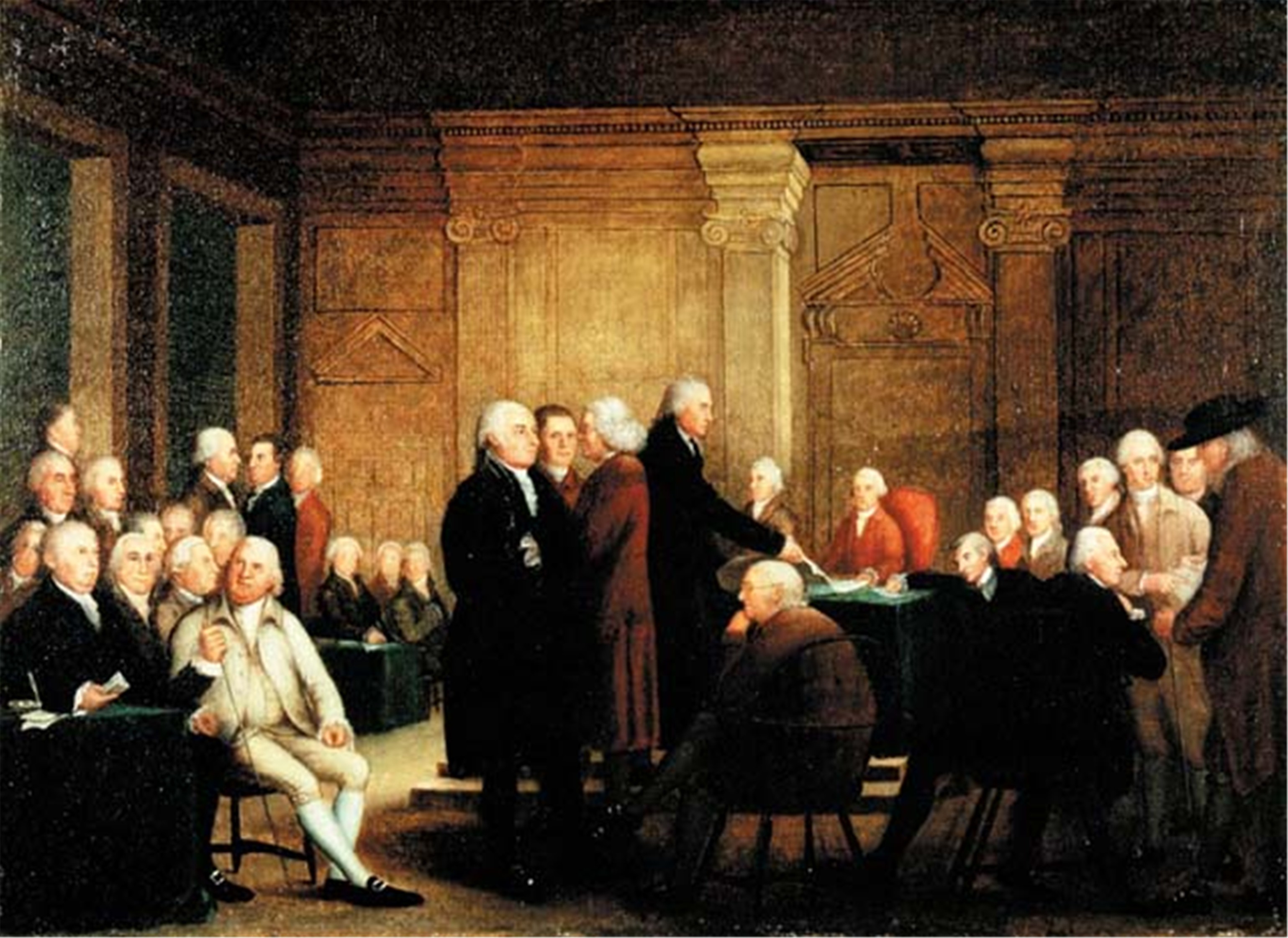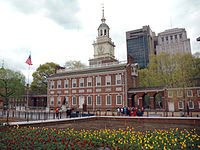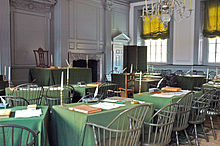This is an old revision of this page, as edited by AstronautAnt (talk | contribs) at 21:08, 12 May 2014 (Undid revision 608280806 by !!arivera!!acr (talk)). The present address (URL) is a permanent link to this revision, which may differ significantly from the current revision.
Revision as of 21:08, 12 May 2014 by AstronautAnt (talk | contribs) (Undid revision 608280806 by !!arivera!!acr (talk))(diff) ← Previous revision | Latest revision (diff) | Newer revision → (diff)
 | |
| History | |
| Established | May 10, 1775 |
| Disbanded | March 1, 1781 |
| Preceded by | First Continental Congress |
| Succeeded by | 1st Confederation Congress |
| Footnotes | |
| Though there were about 50 members of the Congress at a given time, it was the states that had votes, so there were effectively only 13 seats. | |
The Second Continental Congress was a convention of delegates from the Thirteen Colonies that started meeting in the summer of 1775, in Philadelphia, Pennsylvania, soon after warfare in the American Revolutionary War had begun. It succeeded the First Continental Congress, which met between September 5, 1774 and October 25, 1774, also in Philadelphia. The second Congress managed the colonial war effort, and moved incrementally towards independence, adopting the United States Declaration of Independence on July 4, 1776. By raising armies, directing strategy, appointing diplomats, and making formal treaties, the Congress acted as the de facto national government of what became the United States.
When the Second Continental Congress came together on May 10, 1775 it was, in effect, a reconvening of the First Continental Congress. Many of the same 56 delegates who attended the first meeting were in attendance at the second, and the delegates appointed the same president (Peyton Randolph) and secretary (Charles Thomson). Notable new arrivals included Benjamin Franklin of Pennsylvania and John Hancock of Massachusetts. Within two weeks, Randolph was summoned back to Virginia to preside over the House of Burgesses; he was replaced in the Virginia delegation by Thomas Jefferson, who arrived several weeks later. Henry Middleton was elected as president to replace Randolph, but he declined. Hancock was elected president on May 24.
Delegates from twelve of the Thirteen Colonies were present when the Second Continental Congress convened. Georgia had not participated in the First Continental Congress and did not initially send delegates to the Second Continental Congress. On May 13, 1775, Lyman Hall was admitted as a delegate from the Parish of St. John's in the Colony of Georgia, not as a delegate from the colony itself. On July 4, 1775, revolutionary Georgians held a Provincial Congress to decide how to respond to the American Revolution, and that congress decided on July 8 to send delegates to the Continental Congress. They arrived on July 20.
History
| This section needs additional citations for verification. Please help improve this article by adding citations to reliable sources in this section. Unsourced material may be challenged and removed. Find sources: "Second Continental Congress" – news · newspapers · books · scholar · JSTOR (May 2013) (Learn how and when to remove this message) |
| This article is part of a series on the |
| United States Continental Congress |
|---|
 Independence Hall in Philadelphia Independence Hall in Philadelphia |
| Predecessors |
| First Continental Congress |
| Second Continental Congress |
| Congress of the Confederation |
| Members |
| Related |
|
|
Its predecessor, the First Continental Congress, had sent entreaties to the British King George III to stop the Coercive Acts and had created the Continental Association to establish a coordinated protest of the Coercive Acts; in particular, a boycott had been placed on British goods. That First Congress provided that the Second Continental Congress would meet on May 10, 1775, to plan further responses if the British government had not repealed or modified the Coercive Acts.
By the time the Second Continental Congress met, the American Revolutionary War had already started with the Battles of Lexington and Concord. The Congress was to take charge of the war effort. For the first few months of the struggle, the Patriots had carried on their struggle in an ad-hoc and uncoordinated manner. They had seized arsenals, driven out royal officials, and besieged the British army in the city of Boston. On June 14, 1775, the Congress voted to create the Continental Army out of the militia units around Boston and quickly appointed Congressman George Washington of Virginia as commanding general of the Continental Army. On July 6, 1775 Congress approved a Declaration of Causes outlining the rationale and necessity for taking up arms in the Thirteen Colonies." On July 8, Congress extended the Olive Branch Petition to the British Crown as a final attempt at reconciliation. However, it was received too late to do any good. Silas Deane was sent to France as a minister (ambassador) of the Congress. American ports were reopened in defiance of the British Navigation Acts.
Although it had no explicit legal authority to govern, it assumed all the functions of a national government, such as appointing ambassadors, signing treaties, raising armies, appointing generals, obtaining loans from Europe, issuing paper money (called "Continentals"), and disbursing funds. The Congress had no authority to levy taxes, and was required to request money, supplies, and troops from the states to support the war effort. Individual states frequently ignored these requests. According to one historian, commenting on the source of the Congress' power:
The appointment of the delegates to both these congresses was generally by popular conventions, though in some instances by state assemblies. But in neither case can the appointing body be considered the original depository of the power by which the delegates acted; for the conventions were either self-appointed "committees of safety" or hastily assembled popular gatherings, including but a small fraction of the population to be represented, and the state assemblies had no right to surrender to another body one atom of the power which had been granted to them, or to create a new power which should govern the people without their will. The source of the powers of congress is to be sought solely in the acquiescence of the people, without which every congressional resolution, with or without the benediction of popular conventions or state legislatures, would have been a mere brutum fulmen; and, as the congress unquestionably exercised national powers, operating over the whole country, the conclusion is inevitable that the will of the whole people is the source of national government in the United States, even from its first imperfect appearance in the second continental congress.. Cyclopædia of Political Science. New York: Maynard, Merrill, and Co., 1899.
Congress was moving towards declaring independence from the British Empire in 1776, but many delegates lacked the authority from their home governments to take such an action. Advocates of independence in Congress moved to have reluctant colonial governments revise instructions to their delegations, or even replace those governments which would not authorize independence. On May 10, 1776, Congress passed a resolution recommending that any colony lacking a proper (i.e. a revolutionary) government should form such. On May 15 Congress adopted a more radical preamble to this resolution, drafted by John Adams, in which it advised throwing off oaths of allegiance and suppressing the authority of the Crown in any colonial government that still derived its authority from the Crown. That same day the Virginia Convention instructed its delegation in Philadelphia to propose a resolution that called for a declaration of independence, the formation of foreign alliances, and a confederation of the states. The resolution of independence was delayed for several weeks as revolutionaries consolidated support for independence in their home governments.

The records of the Continental Congress confirm that the need for a declaration of independence was intimately linked with the demands of international relations. On June 7, 1776, Richard Henry Lee tabled a resolution before the Continental Congress declaring the colonies independent. He also urged Congress to resolve "to take the most effectual measures for forming foreign Alliances" and to prepare a plan of confederation for the newly independent states. Lee argued that independence was the only way to ensure a foreign alliance, since no European monarchs would deal with America if they remained Britain's colonists. American leaders had rejected the divine right of kings in the New World, but recognized the necessity of proving their credibility in the Old World. Congress would formally adopt the resolution of independence, but only after creating three overlapping committees to draft the Declaration, a Model Treaty, and the Articles of Confederation. The Declaration announced the states' entry into the international system; the model treaty was designed to establish amity and commerce with other states; and the Articles of Confederation, which established "a firm league" among the thirteen free and independent states; together these constituted an international agreement to set up central institutions for the conduct of vital domestic and foreign affairs.
Congress finally approved the resolution of independence on July 2, 1776. Congress next turned its attention to a formal explanation of this decision, the United States Declaration of Independence, which was approved on July 4 and published soon thereafter.
The Congress moved from Philadelphia to Baltimore in the winter of 1776 to avoid capture by British forces, who were advancing on Philadelphia. As the largest building in then forty-seven year old Baltimore Town, Henry Fite's tavern provided a comfortable location of sufficient size for Congress to meet; its site at the western edge of town was beyond easy reach of the British Royal Navy's ships should they try to sail up the Harbor and the Patapsco River to shell the town. The Continental Congress was again forced to flee Philadelphia at the end of September 1777, as British troops occupied the city. The Congress moved to York, Pennsylvania, and continued their work.
After more than a year of debate, on November 15, 1777, Congress passed and sent to the states for ratification the Articles of Confederation. The issue was large states wanting a larger say, nullified by small states who feared tyranny. Jefferson's proposal for a Senate to represent the states and a House to represent the people was rejected (a similar proposal was adopted later in the United States Constitution). The small states won and each state had one vote. Congress urged the individual states to pass the Articles as quickly as possible, but it took three and a half years for all the states to ratify the Articles. Of the then thirteen states, the State Legislature of Virginia was the first to ratify the Articles, on December 16, 1777, and the State Legislature of Maryland became the last to do so, on February 2, 1781. In the meantime, the Second Continental Congress tried to lead the new country through the war with borrowed money and no taxing power.
Finally, on March 1, 1781, the Articles of Confederation were signed by delegates of Maryland at a meeting of the Second Continental Congress, which then declared the Articles ratified. On the next day, the same congressional delegates met as the new Congress of the Confederation. As historian Edmund Burnett wrote, "There was no new organization of any kind, not even the election of a new President." The congress still called itself the Continental Congress. It would be the Confederation Congress that would oversee the conclusion of the American Revolution.
Dates and places of sessions
- May 10, 1775 – December 12, 1776, Philadelphia, Pennsylvania
- December 20, 1776 – March 4, 1777, Baltimore, Maryland
- March 5, 1777 – September 18, 1777, Philadelphia
- September 27, 1777 (one day only), Lancaster, Pennsylvania
- September 30, 1777 – June 27, 1778, York, Pennsylvania
- July 2, 1778 – March 1, 1781, Philadelphia
See also
- History of the United States (1776–1789)
- Timeline of United States revolutionary history (1760–1789)
- List of delegates to the Continental Congress
- Presidents of the Continental Congress
Notes
- Cogliano, Revolutionary America, 1763-1815, 113.
- Burnett, Continental Congress, 64–67.
- Fowler, Baron of Beacon Hill, 189.
- Worthington C. Ford, et al. (ed.), ed. (1904–1939). Journals of the Continental Congress, 1774–1789. Washington, DC. pp. 2:44–48.
{{cite book}}:|editor=has generic name (help)CS1 maint: location missing publisher (link) - ibid. pp. 2:192–193.
- Cogliano, Revolutionary America, 1763-1815, 59.
- Find Documents: Results
- Bancroft, Ch. 34, p.353 (online)
- ^ The Declaration of Independence in World Context, Organization of American Historians, Magazine of History, Volume18, Issue 3, Pp. 61-66 (2004)
- Howard Jones, Crucible of power: a history of American foreign relations to 1913
- Miller (1948) ch 22
- Burnett, Continental Congress, 503.
References
- Burnett, Edward Cody (1941). The Continental Congress. New York: Norton.
{{cite book}}: Cite has empty unknown parameter:|coauthors=(help) - Fowler, William M., Jr. (1980). The Baron of Beacon Hill: A Biography of John Hancock. Boston: Houghton Mifflin. ISBN 0-395-27619-5.
{{cite book}}: Cite has empty unknown parameter:|coauthors=(help)CS1 maint: multiple names: authors list (link)
Further reading
- Adams, Willi Paul. The First American Constitutions: Republican Ideology and the Making of the State Constitutions in the Revolutionary Era. U. of North Carolina Press, 1980. ISBN 0-7425-2069-2
- Francis D. Cogliano, Revolutionary America, 1763-1815: A Political History. London: 2000. ISBN 0-415-18057-0
- Worthington C. Ford, et al. ed. Journals of the Continental Congress, 1774–1789. (34 vol., 1904–1937) online edition
- Henderson, H. James (2002) . Party Politics in the Continental Congress. Rowman & Littlefield. ISBN 0-8191-6525-5.
- Peter Force, ed. American Archives 9 vol 1837-1853, major compilation of documents 1774-1776. online edition
- Kruman, Marc W. Between Authority and Liberty: State Constitution Making in Revolutionary America. U. of North Carolina Pr., 1997. ISBN 0-8078-4797-6
- Maier, Pauline. American Scripture: Making the Declaration of Independence (1998)
- Miller, John C. Triumph of Freedom, 1775-1783 (1948) ISBN 0-313-20779-8
- Montross, Lynn (1970) . The Reluctant Rebels; the Story of the Continental Congress, 1774–1789. Barnes & Noble. ISBN 0-389-03973-X.
- Rakove, Jack N. The Beginnings of National Politics: An Interpretive History of the Continental Congress. Knopf, 1979. ISBN 0-8018-2864-3
External links
- Full text of Journals of the Continental Congress, 1774–1789
- Letters of Delegates to Congress, 1774-1789
- Interactive Flash Version of John Trumbull's "Declaration of Independence"
| Preceded byFirst Continental Congress | National Legislature of the United States May 10, 1775 – March 1, 1781 |
Succeeded byCongress of the Confederation |
| Pennsylvania in the American Revolution | ||
|---|---|---|
| 1774 |  | |
| 1775 | ||
| 1776 | ||
| 1777 | ||
| 1778 | ||
| 1781 | ||
| 1783 | ||
| Location of the capital of the United States | |
|---|---|
| Temporary capitals |
|
| Permanent capital |
|
| Government of the United States under the Articles of Confederation | |
|---|---|
| Congresses | |
| Congressional Officers | |
| Civil Offices/Officers | |
| Military | |
| Meeting sites | |
| Related | |